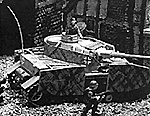WW II miniatures gaming has undergone a bit of a change in recent years. Where once the accepted game scales had one stand of figures or model representing one squad (or less) or one vehicle and one turn representing a very short time, now there are several rules sets on the market in which stands of figures or models represent platoon (or larger) sized formations. Turns no longer represent one or two minutes but represent anywhere from fifteen minutes to a half an hour. I find this particularly interesting because of my pet hobby horse - that of having players make decisions appropriate to their notional command level in a game.
Unfortunately, from many players' points of view, this limits battles, unless many players are involved, each with a company or so of troops, to relatively small engagements. One remedy has been to simply increase the size of each players force until a large game can be played with a reasonable number of players. The problem, as I see it, is that one winds up with players imitating battalion commanders but still being vitally concerned with the ammunition supply carried by and the specific damage inflicted so far on the third vehicle of the second platoon, as well as trying to individually maneuver each vehicle in their (battalion) command.
There's also the matter, nicely discussed by Frank Chadwick in his notes to Command Decision, that, using rules with turns only a couple of minutes long, larger battles simply play too fast. Time seems to compress relative to how long an actual battle took to fight.
The following scenario, Assault on Korpetsch, portraying a German regimental attack on a Soviet-held town, took, in real life, about three hours to fight. Using any of the one-to-one scale rules on the market today, I wager it'd take much less time in game terms than that I plan to try this out at some point and will report back via the letters column. This article will, in the main, be a replay of the aforementioned scenario, using each Clash of Armor (CoA); Command Decision II (CDII); and Spearhead (SH). It will also try to give some insight into the development of a scenario and some of the questions we faced before and after the scenario was played.
These rules use very similar game scales: one model or stand of miniatures equals approximately one platoon of troops and one turn equals 15 - 30 minutes. Each allowed one to play the scenario in about the same amount of game time that the real battle took. Why the replay? Given these rules basic scale similarities, just about everything else is different. I find them interesting in that they each address the basic question of how to allow a moderate-to-large battle to be fought out in a reasonable time with reasonable results, in very different ways. Though they've all been reviewed in these pages, I think a brief summary of the rules important features is in order.
The Comparison
This article appears in MagWeb (Magazine Web) on the Internet World Wide Web. At the lower scales, players can reasonably run platoon-to-company sized formations. They are aware of the specifics of each vehicle in their force - right down to particular armor thickness at specific angles of impact - and are very concerned with the battle fought from the tank turret. Combat resolution in one of these games tries to determine in detail what happens to each vehicle or squad in the force. This works well - from the point of view of decision making - when players run forces appropriate to the games detail level.
At the lower scales, players can reasonably run platoon-to-company sized formations. They are aware of the specifics of each vehicle in their force - right down to particular armor thickness at specific angles of impact - and are very concerned with the battle fought from the tank turret. Combat resolution in one of these games tries to determine in detail what happens to each vehicle or squad in the force. This works well - from the point of view of decision making - when players run forces appropriate to the games detail level.
Rules Overview (all three sets)
Assault on Korpetsch (historical overview and order of battle)
Clash of Armor replay
Command Decision II replay
Spearhead replay
Conclusion
Back to Table of Contents -- Courier #71
© Copyright 1996 by The Courier Publishing Company.
Other military history articles and gaming articles are available at http://www.magweb.com